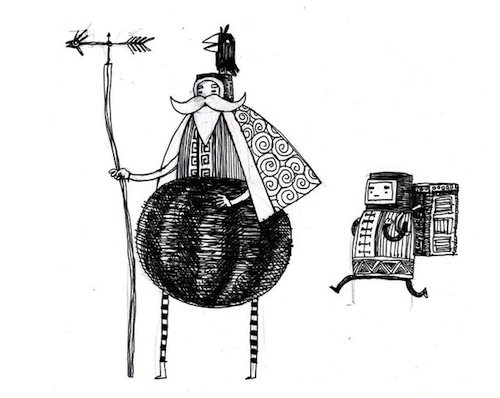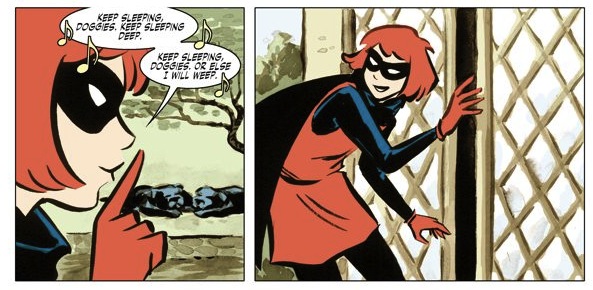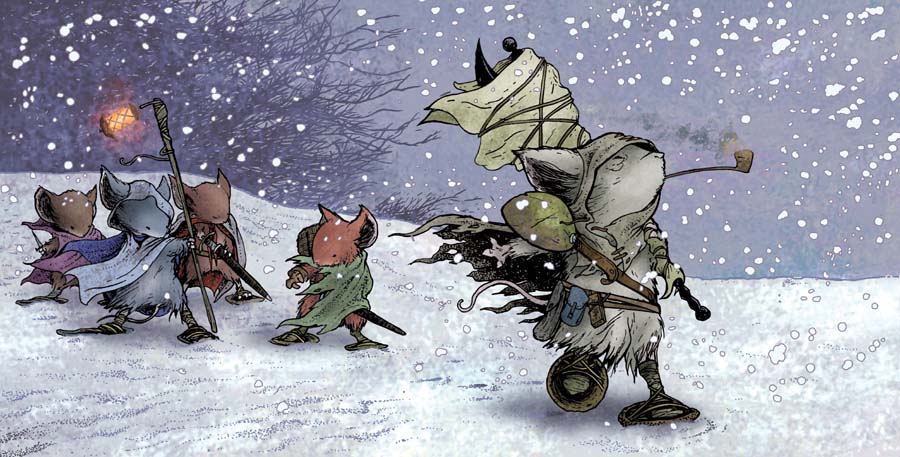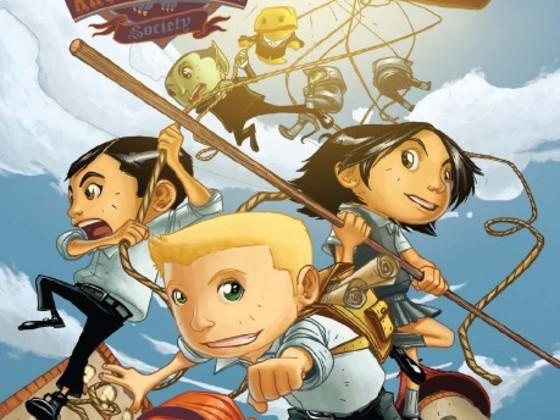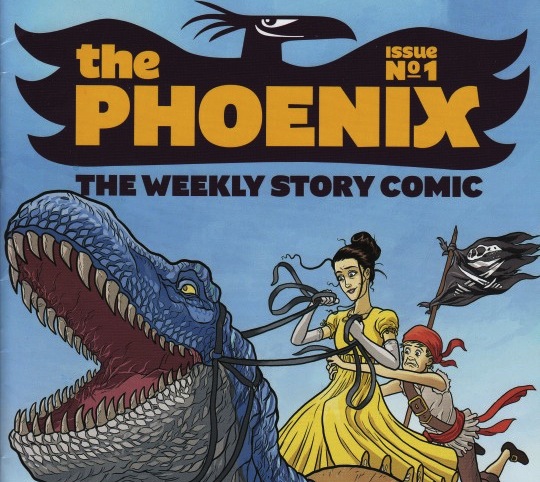Will O' the Wisp is the tale of Aurora Grimeon, a recently-orphaned girl sent to live in a swamp. It's a Southern Gothic occult mystery, and a fine one.
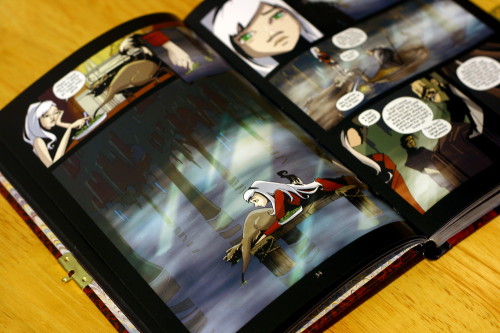
Aurora's parents die suddenly. They made pasta sauce with poisonous mushrooms, and the narrative takes a Roald Dahl-ish relish in this piece of high grotesque adult folly. After being callously handed through a similarly gleeful macabre sketch of child protection services, Aurora is packed off to Ossuary Isle to live with her grandfather Silver in a swamp thick with gravestones and Hoodoo folklore.
If you're not hooked already, I'm worried about you.
My partner picked out Will O' the Wisp from a display table at Dave's Comics in Brighton,where it caught his eye by being a genuinely gorgeous piece of publishing design. It's a neat little hardback with a diary clasp, a high quality finish, and these beautiful marbled endpapers.
You can see a few of the early pages on Comics Alliance, which is enough to give you a feel for the style, and the article calls out some of the cultural touchstones. There's Gaiman, and Burton, and world of spooky synthetic folklore in the mix. Locke and Key, as they say, has some significant narrative and tonal similarities, although both are drawing from a wide pool of tropes. There are echoes of some of the short stories in Hellboy, too. The Baba Yaga stuff that starts in Wake the Devil, perhaps, although I don't have a copy to hand.
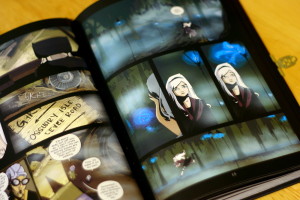 But I also think there's more than a little Lemony Snicket, and from Gaiman in particular, that feeling of childhood's relation to the adult world that a friend of mine described as something like "living in a land under an occupying force whose rules you can't quite understand". There's a whole thesis on children's literature there that I've not read enough to unpack, but it resonates massively, particularly with something like The Ocean at the End of the Lane, or early Harry Potter, I guess.
But I also think there's more than a little Lemony Snicket, and from Gaiman in particular, that feeling of childhood's relation to the adult world that a friend of mine described as something like "living in a land under an occupying force whose rules you can't quite understand". There's a whole thesis on children's literature there that I've not read enough to unpack, but it resonates massively, particularly with something like The Ocean at the End of the Lane, or early Harry Potter, I guess.
In Aurora's world, those rules are a blend of the intractable adult mores that she can only somewhat scratch at, and the practical rules of Hoodoo that influence the life of the isle.
The Hoodoo tradition in the book ranges from casual custom to full-blooded religion. Silver observes details, in part to fit in. From time to time he'll correct wearily with scientific detail, but his heart isn't in sneering. This fits rather neatly with his early description as "the nicest sinister man I ever met". Others take the Hoodoo details as simple factual truth. There are things you must do and not do, there is bad luck to be risked, and the dead to anger. Mama Nonnie, the "local Hoodoo woman" introduces Aurora to the tradition more fully, and as they become friends, Aurora comes to occupy a kind of empirical/mystical middle ground. It's reasonably standard child protagonist stuff that her disruptive enquiring streak and cavalier attitude to received boundaries lets her investigate the mystery of the piece. But to do so she combines Mama Nonnie's wisdom with Silver's gentleman-scientist arcana, and the more workaday Hoodoo and swamp folklore of the people she befriends.
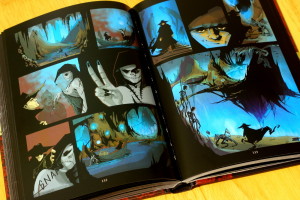 Pausing to be critical, we might suggest that structurally this is the story of a little privileged urban white girl learning and appropriating African-American folk spirituality to eventually triumph and save a comically backward rural community. That reading is available, but I'd argue it's a stretch. Will O' the Wisp's Hoodoo trappings are sketched out as pretty inclusive. I just can't see it in the tone, either, and Aurora's experience of both Hoodoo and the life of the isle are far more participatory and warm. You could also argue that the book's message is that not heeding your elders and religion will get you killed, but I don't quite buy that either. Ultimately, if anything - if - she is assimilated by the swamp, synthesising its magic and her grandfather's rather arcane "science" into something that gives her more belonging and understanding than before.
Pausing to be critical, we might suggest that structurally this is the story of a little privileged urban white girl learning and appropriating African-American folk spirituality to eventually triumph and save a comically backward rural community. That reading is available, but I'd argue it's a stretch. Will O' the Wisp's Hoodoo trappings are sketched out as pretty inclusive. I just can't see it in the tone, either, and Aurora's experience of both Hoodoo and the life of the isle are far more participatory and warm. You could also argue that the book's message is that not heeding your elders and religion will get you killed, but I don't quite buy that either. Ultimately, if anything - if - she is assimilated by the swamp, synthesising its magic and her grandfather's rather arcane "science" into something that gives her more belonging and understanding than before.
Ossuary Isle is exactly what the name implies, and Aurora's story is of exploring it, mythically and geographically. Doing so, she is fascinated by the will o' the wisps that burn around it. Physically, these are pockets of marsh gas that have caught light. Mythically, they are little pieces of hell, carried with him by a man it rejected as too evil. As people begin disappearing and charred corpses are found, it becomes clear that the flickering lights are more than just marsh gas, and something powerful and sinister has returned.
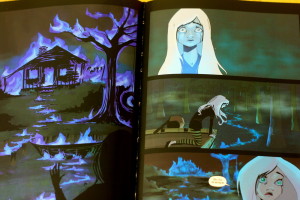 It's charming in places (Missy the pet raccoon is a particular delight, as is the exploration of Hoodoo), moving to the sinister and the acutely sad. People die, and for its nominal "young adult" label, Will O' the Wisp does not pull its punches over this. The death of Aurora's fledgeling sweetheart is particularly cruel.
It's charming in places (Missy the pet raccoon is a particular delight, as is the exploration of Hoodoo), moving to the sinister and the acutely sad. People die, and for its nominal "young adult" label, Will O' the Wisp does not pull its punches over this. The death of Aurora's fledgeling sweetheart is particularly cruel.
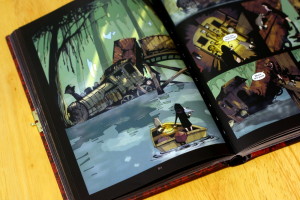 Visually, Will O' the Wisp is as splendid inside as out. There are shades of a gentler, more cartoonish version of Kevin O'Neill's work on League of Extraordinary Gentlemen, but that's not quite it. It's scratchy in places, and the figures are gaunt, partially distorted, playing neatly into the Gothic vibe. It bolts the "Southern" onto that "Gothic" with the closeness of it, the way it has the swamp press in with panel composition. With a writer from the film industry, and an artist with a production design background, it would be lazy to call Will O' the Wisp filmic or cinematic, but there are places where that applies.
Visually, Will O' the Wisp is as splendid inside as out. There are shades of a gentler, more cartoonish version of Kevin O'Neill's work on League of Extraordinary Gentlemen, but that's not quite it. It's scratchy in places, and the figures are gaunt, partially distorted, playing neatly into the Gothic vibe. It bolts the "Southern" onto that "Gothic" with the closeness of it, the way it has the swamp press in with panel composition. With a writer from the film industry, and an artist with a production design background, it would be lazy to call Will O' the Wisp filmic or cinematic, but there are places where that applies. 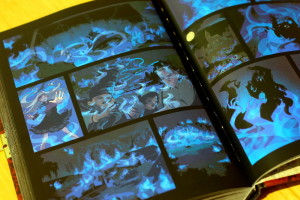 The whole thing has a wonderful sense of light; vital as fire becomes a recurring trope. Shafts of daylight nudge their way through the swamp foliage, mist drifts across the pages, trees press in close. Then suddenly, occasionally, it expands to give us a whole page, like a suddenly-discovered clearing.
The whole thing has a wonderful sense of light; vital as fire becomes a recurring trope. Shafts of daylight nudge their way through the swamp foliage, mist drifts across the pages, trees press in close. Then suddenly, occasionally, it expands to give us a whole page, like a suddenly-discovered clearing.
Will O' the Wisp has one of the tightest matches of art and tone I've seen in a while. Right now, Gillen and McKelvie are doing it better, but that's not playing fair. Change maybe, pulls some of this off too. Although there the real fireworks are the colouring.
Particularly to savour are the visual tone shifts with the recollection of Silver's childhood, the discovery of the deserted paddle steamer, the ongoing eerie play of blue marsh fire, and Mama Nonnie's vision journey into hell.
Will O' the Wisp is subtitled "An Aurora Grimeon Story", and the creators have said they'd like to do more. I'm so up for that. Ossuary Isle and the mysteries of the swamp are a rich setting, and exploring it is great fun. This is a prime slice of curl-up-on-the-sofa reading, and I'd strongly suggest you pick up a copy and do just that.




